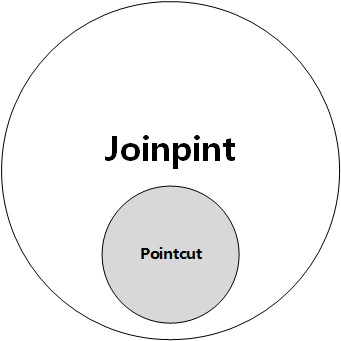基本概念
AOP,即 Aspect-Oriented Programming(面向切面编程),它其实是 OOP(Object-Oriented Programing,面向对象编程)思想的补充和完善。
在使用 Spring AOP 之前,首先需要掌握以下几个常用术语:
1.aspect
aspect,即切面。切面是通知和切点的结合。通知和切点共同定义了关于切面的全部内容。
2.advice
advice,即通知。通知在 AOP 中代表切面的工作,它定义了切面具体要做什么,何时做。
在 Spring 中共有 5 类通知类型,用来分别表示切面在不同时候要做的工作。
前置通知(Before Advice):在切入点选择的连接点处的方法之前执行的通知,该通知不影响正常程序执行流程(除非该通知抛出异常,该异常将中断当前方法链的执行而返回)。
后置通知(After Advice):在切入点选择的连接点处的方法之后执行的通知(无论方法执行是否成功都会被调用)。
后置返回通知(After returning Advice):在切入点选择的连接点处的方法正常执行完毕时执行的通知,必须是连接点处的方法没抛出任何异常正常返回时才调用。
后置异常通知(After throwing Advice): 在切入点选择的连接点处的方法抛出异常返回时执行的通知,必须是连接点处的方法抛出任何异常返回时才调用异常通知。
环绕通知(Around Advices):环绕着在切入点选择的连接点处的方法所执行的通知,环绕通知可以在方法调用之前和之后自定义任何行为,并且可以决定是否执行连接点处的方法、替换返回值、抛出异常等等。
3.pointcut
pointcut,即切点。在 AOP 中切点表示切面生效的地方。
4.joinpoint
joinpoint,连接点。在 AOP 中表示能让切面生效,产生作用的地方。这个点可以是调用方法时,抛出异常时,甚至是字段被修改时。乍看之下会觉的连接点和切点没什么区别,其实它们就是全部与部分的关系,如下图:
实例探究
1.前置通知
首先来看一个关于 Spring AOP 前置通知的简单例子。
- 定义一个 Bean,用它来表示连接点(joinpoint)的一部分
public class Animals {
public void setName(String name) {
System.out.println(name);
}
}- 定义一个 Bean,用来表示切面
public class AnimalsAspect {
// 该方法表示切面的具体工作
public void beforeAdvice() {
System.out.println("before advice..." );
}
}- 在 xml 文件中配置
<!-- 1.容器中注入 Bean -->
<bean id="joinpoint" class="com.demo.Animals" />
<bean id="aspect" class="com.aop.AnimalsAspect"/>
<!-- 2.AOP 配置 -->
<aop:config>
<!-- 2.1指定切面 -->
<aop:aspect ref="aspect">
<!-- 2.2指定通知和切点-->
<!-- before 表示通知类型是前置通知,method 表示通知的具体作用,即指定了切面在何时做什么-->
<!-- pointcut 表示切点,即指定了切面在哪生效-->
<aop:before method="beforeAdvice" pointcut="execution(* com.demo.Animals.setName(..))" />
</aop:aspect>
</aop:config>- 调用验证
String location = ...
ApplicationContext factory = new FileSystemXmlApplicationContext(location);
Animals animals = (Animals) factory.getBean("joinpoint");
animals1.setName("cat");
// 输出结果:
// before advice...
// cat2.后置通知
上面的例子中介绍了 Spring AOP 的简单使用,且具体使用的是 AOP 的前置通知,接下来探究下其他通知类型的作用。
- 定义一个 Bean,用它来表示连接点(joinpoint)的一部分。
public class Animals {
public void setName(String name) {
// 为空时,打印并抛出异常
if(name == null){
System.out.println("Exception");
throw new NullPointerException();
}
System.out.println(name);
}
}- 定义切面
public class AnimalsAspect {
public void afterAdvice() {
System.out.println("after advice...");
}
public void afterReturningAdvice() {
System.out.println("after returning advice...");
}
public void afterThrowingAdvice(Exception exception) {
System.out.println("after throwing advice exception..." );
}
}- 在 xml 配置文件定义:
<!-- 容器中注入 Bean ,同上-->
<!-- AOP 配置 -->
<aop:config>
<!-- 定义切点,简化配置(由于多种通知类型都要作用在该切点)-->
<aop:pointcut expression="execution(* com.demo.Animals.setName(..))" id="pointcut"/>
<aop:aspect ref="aspect">
<!-- 相应的,这里不再使用 pointcut 而使用 poincut-ref 指定切点 -->
<!-- pointcut 和 pointcut-ref 都能指定切点(前者为指定切点,后者为匿名切点)-->
<aop:after method="afterAdvice" pointcut-ref="pointcut"/>
<aop:after-returning method="afterReturningAdvice" pointcut-ref="pointcut"/>
<aop:after-throwing method="afterThrowingAdvice" pointcut-ref="pointcut"/>
</aop:aspect>
</aop:config>- 调用验证
String location = ...
ApplicationContext factory = new FileSystemXmlApplicationContext(location);
Animals animals = (Animals) factory.getBean("joinpoint");
animals1.setName("cat");
animals1.setName(null);
// 输出结果:
// cat
// after advice...
// after returning advice...
//
// Exception
// after advice...
// after throwing advice exception...3.通知参数
到目前的例子中,几乎所有通知类型的方法都是不带参数。下面来看下如何在通知时调用【被通知方法】的方法参数。
- 定义一个 Bean,用它来表示连接点(joinpoint)的一部分。
public class Animals {
public String setName(String name) {
// 为空时,打印并抛出异常
if(name == null){
System.out.println("Exception");
throw new NullPointerException();
}
System.out.println(name);
// 返回值
return "return "+name;
}
}- 定义切面
public class AnimalsAspect {
// 这里需要注意的是:切面的参数类型只有与被通知方法的参数类型一致时才能生效,因此这里采用 Object,因为它能匹配任意类型
public void beforeAdvice(Object param) {
System.out.println("before advice...,param is :"+param);
}
public void afterAdvice(Object param) {
System.out.println("after advice...,param is :"+param);
}
public void afterReturningAdvice(Object param) {
System.out.println("after returning advice...,param is :"+param);
}
public void afterThrowingAdvice(Exception exception) {
System.out.println("after throwing advice exception...,exception is :"+exception);
}
}- 在 xml 配置文件定义:
<!-- 容器中注入 Bean ,同上-->
<!-- AOP 配置 -->
<aop:config>
<!-- 这里定义了两种切点:带参、不带参 -->
<aop:pointcut expression="execution(* com.demo.Animals.setName(..)) and args(param)" id="pointcut"/>
<aop:pointcut expression="execution(* com.demo.Animals.setName(..))" id="point-noparam"/>
<aop:aspect ref="aspect">
<aop:before method="beforeAdvice" pointcut-ref="pointcut" arg-names="param"/>
<aop:after method="afterAdvice" pointcut-ref="pointcut" arg-names="param"/>
<!-- 以下两种通知并没有调用到方法参数,所以使用不带参的切点,注意区别 -->
<aop:after-returning method="afterReturningAdvice" pointcut-ref="point-noparam" returning="param"/>
<aop:after-throwing method="afterThrowingAdvice" pointcut-ref="point-noparam" throwing="exception" />
</aop:aspect>
</aop:config>
- 调用验证:
String location = ...
ApplicationContext factory = new FileSystemXmlApplicationContext(location);
Animals animals = (Animals) factory.getBean("joinpoint");
animals1.setName("cat");
animals1.setName(null);
// 输出结果:
// before advice...,param is :cat
// cat
// after advice...,param is :cat
// after returning advice...,param is :return cat
//
// before advice...,param is :null
// after advice...,param is :null
// after throwing advice exception...,exception is :java.lang.NullPointerException4.环绕通知
环绕通知非常强大,可以决定【被通知方法】是否执行,什么时候执行,执行时是否需要替换方法参数,执行完毕是否需要替换返回值。
定义一个 Bean,用它来表示连接点(joinpoint)的一部分。(同上)
定义切面
public class AnimalsAspect {
// 环绕通知第一个参数必须是 org.aspectj.lang.ProceedingJoinPoint 类型
public void aroundAdvice(ProceedingJoinPoint joinpoint,Object param) throws Throwable {
// 关键 -> 取得方法的入参,由于被通知方法只有一个入参,所以取数组的第一个元素
String param = joinpoint.getArgs()[0];
System.out.println("around before advice..,param is:"+param);
// 关键 -> 执行被通知的方法(替换方法入参,并取得返回值)
Object returnValue = joinpoint.proceed(new Object[]{"replace"});
System.out.println("around after advice.."+returnValue);
}
}- 在 xml 配置文件定义:
<!-- 容器中注入 Bean ,同上-->
<!-- AOP 配置 -->
<aop:config>
<aop:pointcut expression="execution(* com.demo.Animals.setName(..))" id="point-noparam"/>
<aop:aspect ref="aspect">
<aop:around method="aroundAdvice" pointcut-ref="point-noparam"/>
</aop:aspect>
</aop:config>- 调用验证
String location = ...
ApplicationContext factory = new FileSystemXmlApplicationContext(location);
Animals animals = (Animals) factory.getBean("joinpoint");
animals1.setName("cat");
// 输出结果:
// around before advice..,param is cat
// replace
// around after advice..return replace

























 144
144

 被折叠的 条评论
为什么被折叠?
被折叠的 条评论
为什么被折叠?










